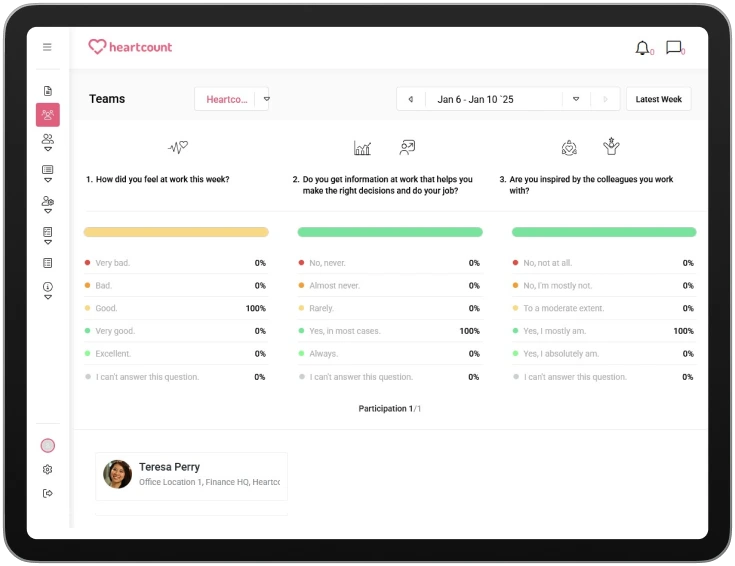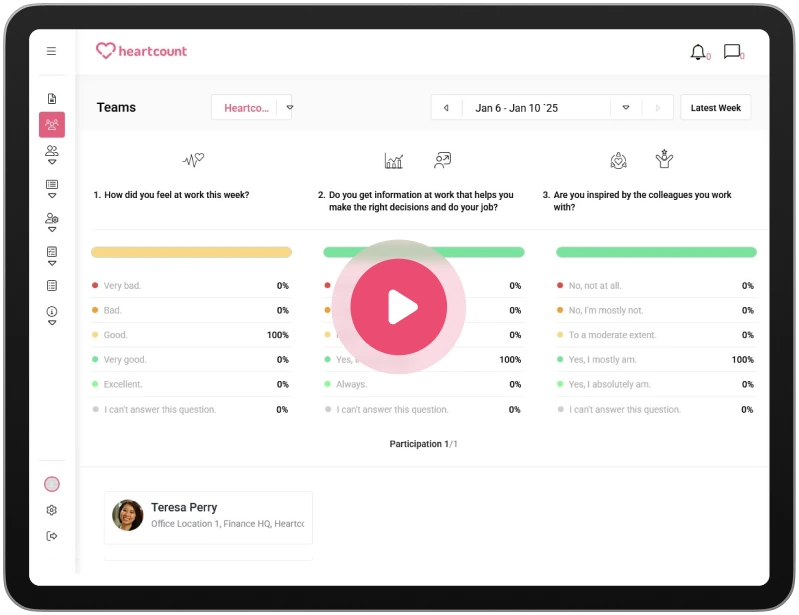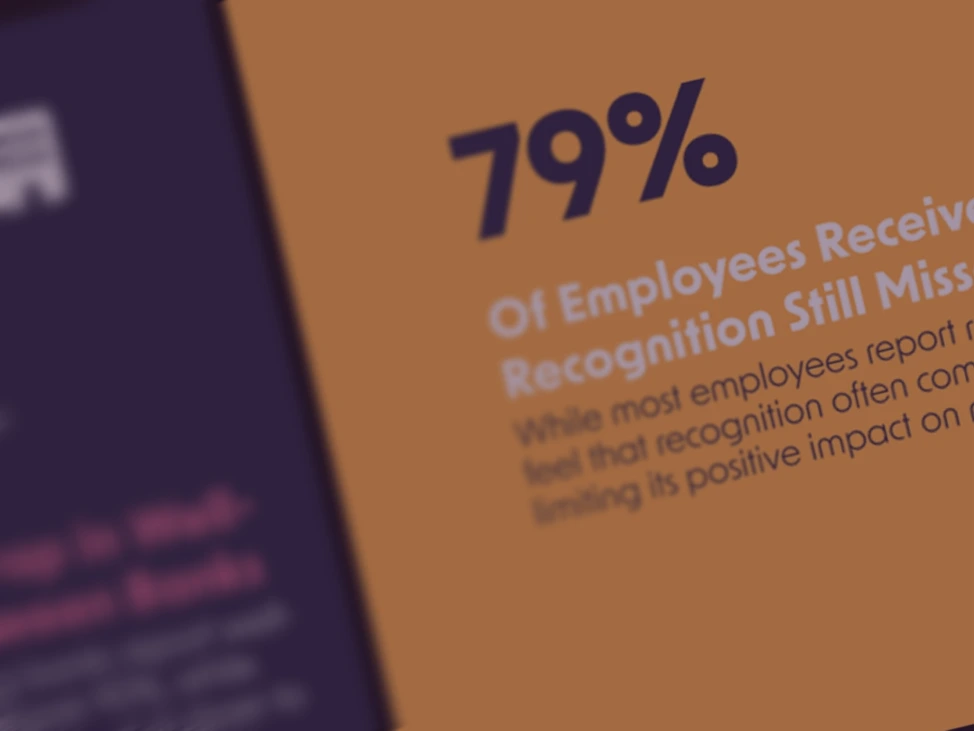How to track employee productivity

Tracking employee productivity solely based on monitoring KPI results is an outdated approach. If you’re still doing things this way, it’s time to stop.
Not only is it inaccurate, but more importantly, it harms company culture. Your employees will more likely resent you than work harder, and the only thing this increases is the stress and anxiety of your workforce.
In other words, productivity doesn’t come where employee satisfaction is low. So, when tracking employee productivity, adopt a broader approach that focuses on outcomes, encourages open communication, recognizes contributions, and promotes work-life balance.
-
1.What is employee productivity?
-
2.Importance of tracking employee productivity
-
3.Factors affecting employee productivity
-
4.Potential drawbacks of tracking employee productivity?
-
5.How to create a positive culture around employee productivity tracking?
-
6.How to track employee productivity?
-
7.Conclusion
Tracking employee productivity solely based on monitoring KPI results is an outdated approach. If you’re still doing things this way, it’s time to stop.
Not only is it inaccurate, but more importantly, it harms company culture. Your employees will more likely resent you than work harder, and the only thing this increases is the stress and anxiety of your workforce.
In other words, productivity doesn’t come where employee satisfaction is low. So, when tracking employee productivity, adopt a broader approach that focuses on outcomes, encourages open communication, recognizes contributions, and promotes work-life balance.
What is employee productivity?
Employee productivity, or workforce productivity, is a quantifiable measure of the efficiency and effectiveness of an individual or team in accomplishing their tasks, utilizing resources, and contributing to company goals.
You can measure productivity in the workforce based on several key metrics:
- Output-based metrics
Output-based metrics focus on the concrete results your employees produce. They are best used in environments where output is easily quantifiable.
- Time-based metrics
Time-based metrics measure how much time employees spend on a given task or activity. For these metrics, efficiency is the top concern, as is understanding how employees utilize their time to complete their work.
- Quality-based metrics
Measuring employee productivity should consider more than the quantity metrics. It should also include quality metrics to glean insight into how the employees meet the standards and expectations of their role.
- Employee engagement metrics
Finally, employee engagement metrics evaluate an organization’s employee engagement level. They are essential for understanding how well (or poorly) employees are motivated and connected and for enhancing productivity, employee retention, and overall performance.
For example, with the HeartCount platform, you can easily measure eight categories of employee engagement through quick weekly pulse surveys. This helps you track and understand how employees are motivated and connected and how it impacts their productivity.

Differences between effectiveness, efficiency, and productivity
Employee effectiveness, efficiency, and productivity are strongly tied together.
Effectiveness without efficiency or vice versa means the employee reaches their target (effectively) but uses too many resources (not efficiently). Or, they are working quickly (efficiently) but on the wrong task (not effectively).
Once the employee is both practical and efficient, he becomes productive.
Importance of tracking employee productivity
Tracking employee productivity often carries a certain stigma with it.
Employees don’t like it when their employer is monitoring them. According to the American Psychological Association (APA), 56% of workers feel tense or stressed if they know their employer monitors them.
This quickly leads to counterproductive results. Instead of improving productivity, monitoring and surveillance decrease it, which employees see as needing more employer trust.
And when trust is broken, employees are more likely to quit.
According to Raconteur, 63.4% of employees would quit their company if they found their employer was using tracking software.
This dislike of employee productivity monitoring is because companies that use tracking and surveillance software are only concerned with financial results and “hitting quotas” and not at all with their employees’ well-being, happiness, and satisfaction.
You will see your productivity rise once you consider how the employee feels, truly hear their feedback, and act on it.
COLLECT
Factors affecting employee productivity
Understanding the factors affecting employee productivity is crucial for improving overall performance.
These factors can be internal and external.
| Employee Productivity Factors | |
| Internal Factors | External Factors |
| Work environment | Employee family and social obligations |
| Training and development opportunities | Competing career opportunities |
| Employee personalities and characteristics | Regulations |
| Work relationships and job view | Economic and market conditions |
| Employee well-being and health | |
Internal factors
Internal employee productivity factors include factors inside the organization.
These are:
- Work environment
Productivity is greatly affected by the environment the employee is working in. A positive and supportive work environment naturally promotes productivity, while a toxic work environment reduces it.
- Training and development opportunities
Another internal factor that dramatically impacts your employees’ productivity is how many training and development opportunities you offer them for personal and professional growth. Investing in your employees benefits you and them in the long run, while neglecting their training and development leads to a disengaged and inefficient workforce.
- Employee personalities and characteristics
Not every employee is the same. For instance, an employee can be highly skilled but won’t be productive if they are not proactive or don’t adapt well to their new team.
- Work relationships and job view
How employees feel about their colleagues and managers is important to their productivity. If they have a positive relationship with them, they are much more likely to be productive and motivate others to be fruitful.
Also important is how the employee feels about the job they are performing. If the employee doesn’t find their work meaningful, they will inevitably spend less and less effort on it.
- Employee well-being and health
Finally, when we discuss internal productivity factors, we must consider physical and mental employee health. Providing employees with wellness programs and focusing on work-life balance directly influence productivity.
External factors
External factors are factors outside the organization. As such, as an HR manager or team/department leader, you have less (often none) influence over them. Despite that, they are essential to consider.
External factors might be:
- Employee family and social obligations
One colossal mistake organizations make is acting like employees have no life or obligations outside their work.
Most of us simultaneously hold multiple roles tied to our family, friends and community while being an employee.
Let’s say an employee must take care of a child (taking them to school, the doctor, etc.). Juggling this responsibility with the one at work can cause their productivity to drop.
- Competing career opportunities
Coming back to opportunities, your company is one of many that can offer them to employees. Competitors can and will do it as well. If employees spot a better opportunity elsewhere, they may become less enthusiastic and committed to their current job.
- Regulations
Of course, companies must comply with the regulations in their industry. This can severely impact overall productivity, especially in heavily regulated industries.
- Economic and market conditions
Finally, economic and market conditions also affect productivity. For instance, during the Covid-19 pandemic, the airline and hotel industries faced serious challenges while food delivery flourished.
The bottom line is that your organization must always be ready to adjust to changing economic and other circumstances.
Potential drawbacks of tracking employee productivity?
Tracking employee productivity can have negative consequences if it is done the wrong way.
These drawbacks can include:
- Overfocusing on quantifiable metrics
Of course, if we can measure something, we should, but this isn’t always possible. For instance, how do you quantify someone’s creative work? What is the formula for calculating an employee’s interpersonal skills?
- Increased stress and anxiety
Unsurprisingly, employees don’t like it when their managers look over their shoulders and monitor them.
Instead of increasing popularity, this has the counter-effect of making employees uneasy and increasing their stress and anxiety. Eventually, this leads to burnout and a drop in productivity.
- Negative employee-employer relationship
Tracking employee productivity is also an excellent way to erode their relationship with the employer.
This can manifest in a few negative ways:
- Creating a “Big Brother” atmosphere, where monitoring is seen by employees as intrusive and negatively affects their morale
- Compromising employee autonomy
- Managers misinterpreting the metrics or the context and unfairly rating employees.
- Potential legal and privacy issues
Federal US laws such as the Electronic Communications Privacy Act (ECP), state laws (California, Connecticut, Delaware, Texas), the EU’s GDPR, and regulations in other countries make employee monitoring legal.
Still, there is a limit to how far the employer can go with it.
First, the employer must notify the employees about monitoring. Failing to do so is unlawful and considered a breach of trust, and employees can file a lawsuit against the employer.
Also, according to the US National Labor Relations Act (NLRA), monitoring employee union activities is illegal, and employers can’t prevent employees from organizing this way.
Employee monitoring can also discriminate against employees, such as when making employment decisions.
Concerning privacy issues, excessive monitoring can be seen as an invasion of employees’ privacy, especially when monitoring their private communications and activities.
Some managers can also use this to target employees with whom they have a grievance, and there is always the potential for misusing the data the employer collects about the employee.
- Adverse effects on company culture
Poorly executed employee monitoring has a severe negative impact on the company culture. Working in an environment where employees are subjected to exorbitant monitoring decreases employee morale, engagement, and trust while increasing anxiety and stress.
Excessive employee monitoring also promotes a toxic work environment by breaking the trust between managers and employees, as employees are less willing to engage in teamwork or take initiative.
How to create a positive culture around employee productivity tracking?
Tracking employee productivity doesn’t have to lead to a negative company culture. If it is done correctly, it can promote a positive one.
Here is what to focus on:
Be transparent about it
Clearly communicate the reasons for tracking their productivity with the employees. Assure them that this is not about micromanaging them but instead learning where they struggle and how you can help them.
For example, HubSpot openly communicates with its employees why it is using tracking software and ensures they understand the benefits for both sides through its blog, newsletter, and the HubSpot Community.
Include and empower employees
Employees are much more likely to accept a productivity tracking system they had a hand in creating and implementing rather than one forced upon them. This is how you ensure they feel valued and respected.
Also, employees should have as much control over their schedule, work conditions, and tasks as possible. Of course, some limits have to be in place, but doing this promotes autonomy and a sense of ownership from employees.
Buffer, for instance, is known for its decentralized decision-making style, explicitly using “task forces” and the Decision-Making model based on Dennis Bakke’s book The Decision Maker.
Naturally, Buffer uses the same approach to involving employees in decision-making regarding employee productivity tracking through transparent communication, surveys and feedback, and democratized data access.
Provide feedback and recognition
Speaking of feedback, there needs to be two-way communication regarding productivity tracking, including constructive criticism and employee recognition.
In other words, don’t forget to praise your employees from time to time.
A great example is Zappos, which uses real-time feedback instead of an annual performance review. At the core of this approach is “holocracy,” or the belief that employees know exactly what is expected of them from a business standpoint.
Provide training and development opportunities
Productivity tracking can give you valuable insight into areas where you can help employees grow. By identifying skill gaps and providing training and development opportunities, you can create a more robust workforce.
For instance, these skill gaps can range from a lack of technological proficiency and emotional and interpersonal skills to a lack of specific managerial attributes.
Keep refining
Think about employee productivity tracking as a constant loop. There’s always a way to improve it, so stay informed on best practices and trends and regularly adapt based on employee feedback.
UNDERSTAND
How to track employee productivity?
Here are a few best practices and tips that will help you track employee productivity, leading to better job satisfaction and performance and less stress and toxic culture:
- Define key objectives
Do you know what you measure and why you track employee productivity? You need clear and measurable goals that employees can understand and can go for.
- Use time tracking and task management tools
How much time do the employees spend on a specific task or project? Do you know when each part of the project is completed, or are you mostly running blind?
Tools like Asana (task management) and Clockify (time tracking) can help you stay on track with the project and the time it takes to complete tasks.
- Do one-on-one meetings
There are some things that you can’t see without talking to employees. Occasionally, sit down with individual employees to hear about their progress, challenges, and ideas for overcoming them.
- Automate tasks
An average office worker spends around 50% of their time on repetitive tasks such as creating or updating documents.
You could say that it’s the “nature of the work.” Still, over time, it only lowers efficiency, reduces innovation, and drains time employees could spend on more meaningful and high-value activities.
Additionally, repetitive tasks negatively impact employee morale and job satisfaction, increasing stress and burnout, and eventually, employees start looking for more meaningful work.
The solution is to automate where possible. AI, like ChatGPT, Perplexity, or Claude, can help by automating document creation and management, email management, calendar scheduling, and tasks like resume screening and onboarding processes for HR managers.
- Promote a healthy work-life balance
A flexible work schedule that allows employees to balance work and personal life is critical, especially for remote workers.
For example, one study of 50,000 global workers found that those who believe they have a good work-life balance will work 21% harder than those who don’t.
- Build trust and a positive culture around productivity tracking
Finally, it aims to create a positive work culture around productivity tracking by being transparent, providing feedback, listening to employee feedback, and ensuring collaborative decision-making.
Conclusion
Employee productivity tracking can easily go wrong, leading to employee dissatisfaction, burnout, a toxic work culture, and higher turnover.
However, if done in a way that emphasizes not the company’s financial outcomes but the employees’ well-being and development, employee performance tracking has a positive effect.
If you want your employees to feel motivated and productive, HeartCount can help you.












